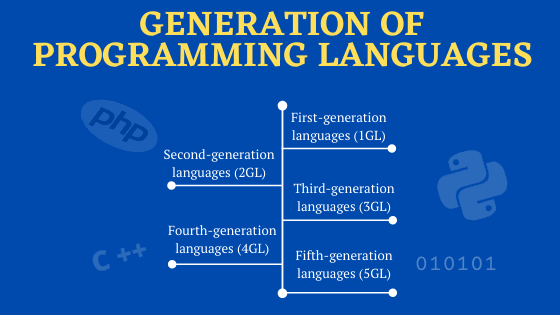What is generation of programming languages? (in detail)

As the programming languages got better and better we started writing down its changes. so that we can know how much programming languages have evolved from the beginning.
every programming language generation’s goal was to become better than their previous generations, as a result, we got better and more user friend programming languages.
The programming language in terms of their performance and upgrades can be grouped into five different generations,
- First-generation languages (1GL)
- Second-generation languages (2GL)
- Third-generation languages (3GL)
- Fourth-generation languages (4GL)
- Fifth-generation languages (5GL)

Table of Contents
First Generation Language (Machine language)
the first generation language, which is commonly known as a low-level programming language.
it is called low-level language because these languages were used to program the computer system at a very low level. i.e, at the machine level.
here machine level means, the programmer only write programs with the binary numbers(0 and 1).
so you can imagine how hard it would be to write programs in 1Gl languages.

advantages of First Generation Language
- since there was no middle man(compiler, interpreter), computers can easily understand the code
- processing was faster in 1GL
- The programs written in these languages efficiently utilize the memory because it was possible to keep track of each bit of data.
Second Generation language (Assembly Language)
just like first-generation languages, second-generation languages is also known as a low-level programming language.
it was slightly better than the first generation language. In the assembly language, symbolic names are used to represent the opcode and the operand part of the instruction.

Advantages of second-generation programming language
- with 2GL, It was easy to develop understand and modify the program, programs developed in these languages compared to those developed in the first generation programming language were way better.
- The programs written in these languages are less prone to errors and therefore can be maintained with a great case.
- writing code was a lot easier now.
Third Generation languages (High-Level Languages)
The languages of this generation were considered as high-level programming languages. because it was designed and developed to reduce the time, cost, and effort needed to develop different types of software applications.
it enabled the programmer to concentrate only on the logic of the programs without considering the internal architecture of the computer system.
Advantages of third-generation programming language
- it was more user friendly than the previous 2 generation languages.
- these languages are less prone to errors they are easy to maintain.
- development with these languages was faster.

examples of second-generation languages
COBOL, FORTRAN, C++, C
Fourth-generation language (Very High-level Languages)
just like third-generation languages, it is also considered as a high-level programming language.
and just like those previous three languages it was also designed and developed to reduce the time, cost, and effort needed to develop different types of software applications.

Advantages of fourth-generation languages
- These programming languages allow the efficient use of data by implementing the various database.
- They require less time, cost, and effort to develop different types of software applications.
- developed in these languages are highly portable as compared to the programs developed in the previous generations of languages.
examples of second-generation languages
Perl, PHP, Python, Ruby, and SQL.
Fifth-generation language (Artificial Intelligence Language)
the fifth-generation language which is considered Artificial Intelligence Language is very different from the previous language,
as the name suggests it is used to develop Artificial Intelligence and Artificial Neural Networks

Advantages of fifth-generation languages
- These languages can be used to query the database in a fast and efficient manner.
- In this generation of language, the user can simply communicate with the computer system.
examples of fifth-generation languages
Mercury, OPS5, and Prolog
also read:
- the five generation of computers and thier history
- How to activate windows 10 using command line (CMD)
- How to dual boot windows 10 and kali linux (Detailed Guide for beginners)
What is service host superfetch? and why you shouldn’t disable superfetch?

![[Fixed] network discovery is turned off in windows 10 - How to turn it on 13 [Fixed] network discovery is turned off in windows 10 – How to turn it on](https://windowsground.com/wp-content/uploads/2022/01/Fixed-network-discovery-is-turned-off-in-windows-10-How-to-turn-it-on-1-768x432.png)




Hey There. I found your blog using msn. This is a really
well written article. I will make sure to bookmark it and
come back to read more of your useful information. Thanks for
the post. I’ll definitely return.
Like!! I blog quite often and I genuinely thank you for your information. The article has truly peaked my interest.
I needed to thank you for this great read!! I definitely loved every little bit of it.
I have got you saved as a favorite to look at new things you post…